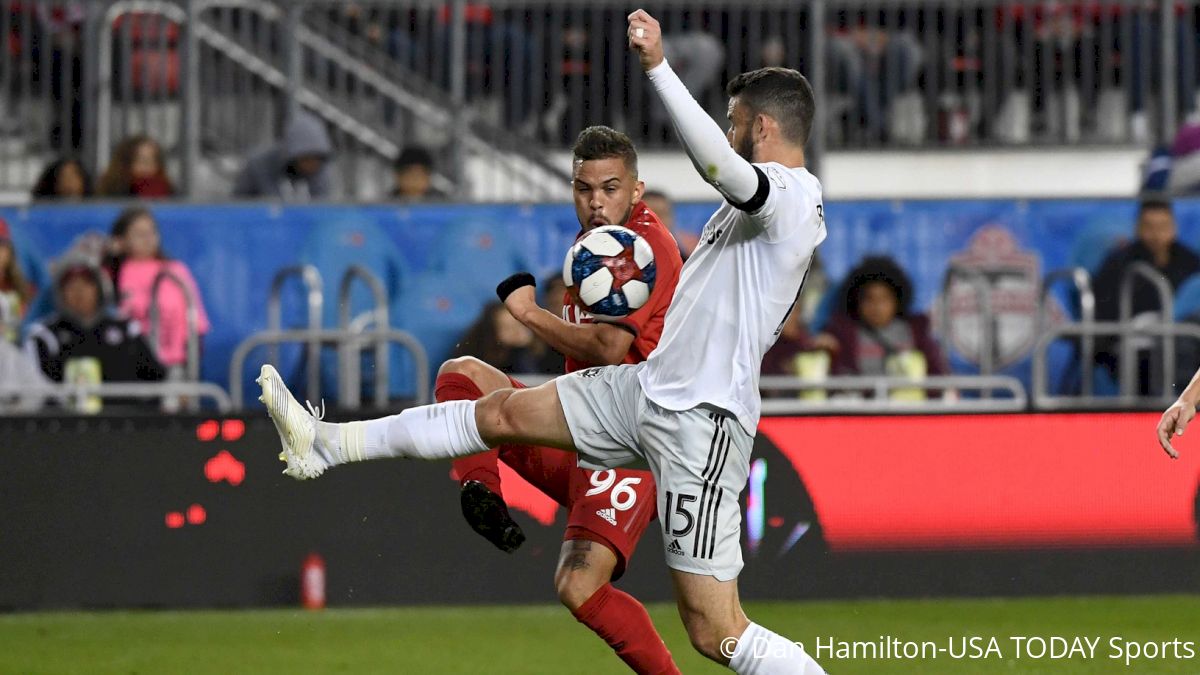Breaking Down D.C. United's Scoreless Draw Against Toronto FC
Breaking Down D.C. United's Scoreless Draw Against Toronto FC
Here's what's on our mind from last night's 0-0 draw between D.C. United and Toronto FC.

D.C. United probably weren't awarded any style points by the judges last night against Toronto FC, but nonetheless, the Black-and-Red left BMO Field with a point in a 0-0 draw. United, with a heavily rotated squad, surrendered 35 shots throughout the game, the third most in a single game in MLS history. But few of those shots resulted in good scoring opportunities for the Reds, which allowed D.C. to keep their seventh clean sheet of the season.
With just two full days of rest after the 1-0 win over Sporting Kansas City, Ben Olsen made seven changes to his starting lineup. Without Wayne Rooney, Luciano Acosta, Paul Arriola, and Lucas Rodriguez from the start, United was set up to play a cagey game, trying to hold the fort down defensively before potentially springing for a goal at the other end.
Rooney, Acosta, and Arriola came in early in the second half, helping to relieve some of the pressure on the defense. But United would end the night with only three shots, one of which came in the second half. The team now faces another quick turnaround, but before Saturday's game at Houston, let's discuss a couple of things from last night's draw.
Heavy Rotation
Olsen never tips his hand early as to what his lineups might be from game to game. But most people thought, or assumed, that last night he would roll with a similar lineup as the one against SKC, mostly because it was a game against an Eastern Conference foe, and in the balance of the season a win or draw against a team from the East for United is more important than one against a team from the West.
But that wasn't the case with the lineup on Wednesday, with just Bill Hamid, Steven Birnbaum, Frederic Brillant, and Russell Canouse being the holdovers from the win against Sporting.
That meant a debut for Akeem Ward, a first start of the year for Quincy Amarikwa, and second starts for Zoltan Stieber, Chris McCann, Jalen Robinson, and Ulises Segura. Only Chris Durkin, who filled in for the absent Junior Moreno, had more than one start this year entering the game last night.
It's a group of players that hasn't had time together on the field, and yet they were able to hold on for 90 minutes to get a vital point on the road. Other than Stieber's shot in the first minute and Amarikwa's goal called back for offside right after, the Black-and-Red didn't threaten the goal much. But they let Olsen rest some of his starters, and starved TFC of vital points at home.
Job done.
Another Game, Another Formation
For the third consecutive game now, Olsen has used a different formation for his starting lineup. First, it was the 3-4-2-1 in the 3-1 win over the Columbus Crew. Then on Sunday, United finally got back to their more familiar 4-2-3-1, with Marquinhos Pedroso making his team debut at left back. Versus Toronto, Olsen used another three center back setup, but this time, the formation was more of a 5-3-2.
Ward and Segura flanked Birnbaum, Brillant, and Robinson, but spent more time as part of the back line, making United's defensive form a five-man line of defense. Then in midfield, it was another flat line with McCann, Durkin, and Canouse, leaving Amarikwa and Stieber up top as the lone attackers from the start.
Formations aren't quite as important as the roles that players are asked to fill on the field, but this was another sign of Olsen making adjustments to best suit the set of players he started. In the past, the head coach was more likely to stick with the same formation from game to game, shoehorning players into roles as need be.
But last year, with the midseason switch to the 4-2-3-1, and this year, with the various formations he's used, has shown that Olsen is more willing to make adjustments on the fly. The team's preferred look is still the 4-2-3-1, but Wednesday night showed that United was capable of deploying yet another setup, which might prove useful in the future.
35 Shots Is A Lot, But...
United was under a constant barrage of shots on Wednesday night, giving up the third most ever by a team in a MLS game. Twenty attempts in the first half and 15 in the second, meant that the Reds were constantly getting the ball near United's box, at least in range of the goal. The only two players out of the 14 that Toronto used that didn't have a shot at some point in the game were center back Drew Moor and goalkeeper Quentin Westberg.
But for all those shots, there were few great scoring chances for the hosts. Here's an illustration of Toronto's expected goals for the evening:
I have to imagine DC United are happy to walk away with a draw. They held Toronto to only one really good chance, while creating nothing. #TFClive #DCU pic.twitter.com/gb9xAFxnsg
— Eliot McKinley (@etmckinley) May 16, 2019
The Reds ended the game with an xG total of 2.51, according to Opta. That's a good number, and in most games that would usually result in at least one goal. However, in most games, a team doesn't typically take 35 shots. Which means that TFC's expected goals number is a bit bloated, just based on the amount of shots they took. Of course, there were a couple of good chances, mostly from Jordan Hamilton, but those opportunities were few and far between.
Now, United won't want to make a habit of allowing opponents that many looks at goal. But lineups and performances like the one Wednesday night won't be commonplace, meaning this should be a one-off instance for the Black-and-Red.